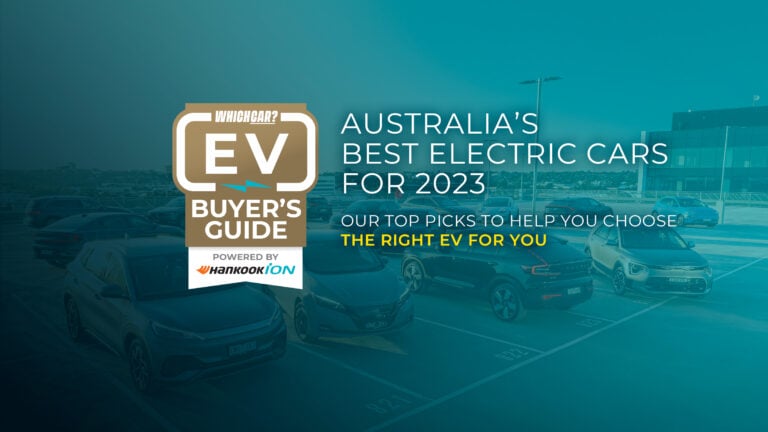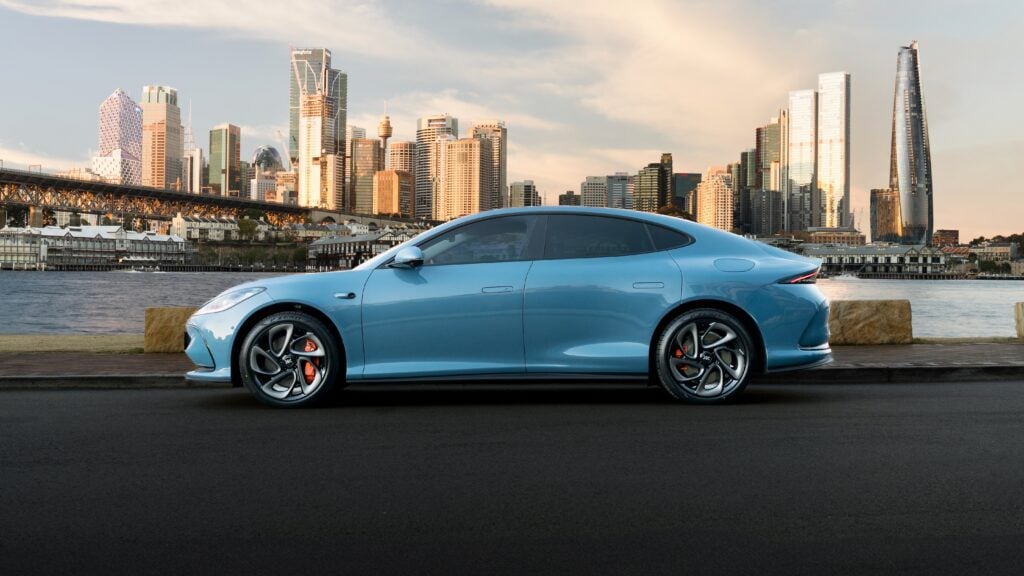
Electric cars: You’ve got questions. We’ve got answers.
For a lot of people, electric cars an exciting prospect, while for others they’re a confusing concept, alien in so many ways to everything they’ve ever known about motoring. For others still, EVs seem like a frustrating compromise, especially when it comes to driving range and the ongoing debate over just how green they truly are.
In this guide, we’re working to answer the most common questions. The truth is that there are still a lot of unknowns about how electric cars will fit in with Australia’s motoring needs, but for those who think they might be getting close to a switch, this guide might have the answers you seek.
JUMP AHEAD
- Will EVs get cheaper to buy brand-new?
- Is the electricity grid ready for more EVs?
- How much does it cost to run an EV versus an ICE car?
- Are EVs really that ‘green’?
- Are EVs cheaper to service?
- Are EVs more expensive to insure?
- When do the batteries need replacing?
- Do EVs hold their value?
- Should I consider a second-hand EV?
- Can an EV power my house as a battery?
- Can I charge my EV on the street?
- Are more public charge points being built?
- Are EV batteries more dangerous than petrol?
- Will ICE cars be banned? If yes, when?
- What happens if I run out of charge in the middle of nowhere?
- What’s this I hear about solid-state batteries being the next big thing?
- What’s happening with hydrogen Fuel Cell Electric Vehicles (FCEVs)?
Will EVs get cheaper to buy brand-new?
More affordable models from mainstream brands are in the pipeline, while economies of scale as larger volumes of EVs are produced industry-wide will lower costs and accessibility of EVs in Australia.
EV purchase price is projected to be on par with ICE models in the US by 2024, and Europe by 2027, so may reach parity in Australia shortly after.
Is the electricity grid ready for more EVs?
It’s debatable. Australia’s National Energy Market (NEM) covers 21 million Australians as the largest grid in the world and is in the midst of its own revitalisation, as many coal-fired stations are approaching their end-of-life. Debate over what to replace them with continues – EVs may help stability by feeding into the grid.

How much does it cost to run an EV versus an ICE car?
High initial expense and personal charging infrastructure make total cost of EV ownership generally more expensive for now.
However, in terms of basic ‘fuel’ costs, EVs are much cheaper. Wheels’ own real-world tests of five EVs against ICE equivalents in 2020 found an average cost advantage of 60.6 percent to charge an EV over filling an ICE’s tank.
For example, in our own testing, driving ‘normally’ we achieved 15.0kWh/100km in the Tesla Model 3 Long Range. In terms of other luxury four-door sedans, to get close to the Tesla’s 4.6sec 0-100km/h acceleration for the $78K price, your only option is really a $76K, twin-turbo V6 Genesis GV70. In normal driving we’ve tested it at 10.2L/100km. It does 0-100km/h in 4.7sec.

Let’s say you do 1000km in each car, again driving ‘normally’, at Melbourne’s 95RON and peak home electricity prices (as this issue of Wheels closed for press). It would cost $28 in the Tesla and $160 in the Genesis. Use Tesla’s Supercharger network and the Model 3’s cost would be $78.
If you care less about acceleration, a $78K four-cyl BMW 330i (0-100km/h in 5.9sec) would cost $103 to do 1000km. That’s using the optimistic ADR consumption figure of 6.6L/100km.
Obviously, there are countless variables making this anything but scientific or definitive. For example, sign up to a special off-peak EV electricity plan or install home solar and your EV costs plummet further.
Are EVs really that ‘green’?
It’s true that EVs have a greater impact on the environment when produced. However, this can balance out with lower operational impact for a reduced overall footprint. The major factor in determining when an EV becomes better for the environment in its lifespan against an ICE model is the source of electricity.
For Australians, that means in NSW and Victoria, which rely heavily on fossil fuel, it takes far longer to cross that threshold than in South Australia, with 58 percent of power renewable, or Tasmania, where this soars to 98 percent.
Battery disposal is also an ever-growing issue, and while there are recycling processes in place, in Australia we only recycle around two percent of the 3300 tonnes of lithium-ion waste created annually. The CSIRO has forecast this waste to grow to as much as 188,000 tonnes by 2036.

Are EVs cheaper to service?
EVs have fewer moving parts and require less significant servicing.
Thanks to their characteristic ‘single-pedal’ driving operation, brake wear is reduced, too. While there is still wear on tyres, suspension components and electronic items, ‘serviceable’ physical parts are reduced for generally lower cost.
OTA (Over-the-Air) updates will increasingly offer smartphone-like software upgrades for consumers, which can bring efficiency improvements and longer driving ranges, but there are still many serviceable items on EVs, known as ‘consumables’.
Tyres, suspension, brakes and filters still need replacing, wheel bearings degrade, windscreens still break, electrics and various motors can fail…

Are EVs more expensive to insure?
Comprehensive insurance for an EV is marginally more than the equivalent ICE. As with an ICE model, this reflects the higher purchase/replacement cost of the vehicle.
What also factors into EV insurance premium is the higher cost of repair, which encompasses expensive battery parts as well as fewer qualified repair workshops – this will change over time.
When do the batteries need replacing?
Battery life varies between makes and models and charging/driving use, especially when looking at older models with earlier battery technology. Toyota offers a 10-year warranty on its batteries, while Nissan, Mitsubishi and Hyundai offer eight-year coverage.
This doesn’t mean the batteries fail, but typically it covers capacity. Most manufacturers guarantee 80 per cent capacity for the warranty period. BMW says its battery packs can last up to 15 years.
In the story below, see the section on battery life.

Do EVs hold their value?
The relative rarity and increasing acceptance of EVs in Australia means they hold their value favourably against ICE vehicles, in some cases better.
With only a small pool of used EVs to choose from, and a lot of excitement about making the big leap, residuals have so far remained relatively strong.
EVs are subject to the market forces too, of course, such as the arrival of a new, more capable model.
Conversely, collectability is there, too, with prices of the original 2011 Tesla Roadster beyond $150K – not far off the original $206K ask.
In the story below, see the section on depreciation.
Should I consider a second-hand EV?
Absolutely. A second-hand EV can make an excellent purchase, but it’s a matter of research and knowledge, just as buying any new or used car. Subsidies and benefits in some states may apply to used EV models, too.
Can an EV power my house as a battery?
V2G (Vehicle to Grid) charging has been touted as great way to return excess renewable power to an electricity grid. Generally, first-generation EVs are uni-directional, and cannot feed back into the grid.
Second-gen EVs, like the Nissan Leaf e+, have bi-directional power and can act as a residential battery system to potentially power your home – or a portion of it.

Can I charge my EV on the street?
Theoretically, yes, but it’s not ideal… you can charge most EVs by a regular 240v socket, but that method is slow, and a long extension-lead from your home to the car may not be the best idea.
Are more public charge points being built?
There are currently more than 3000 public EV charging points at 1650 locations across Australia, and that’s set to more than double in the next few years. US company Jolt announced in August a plan for 5000 public chargers, while the Future Fuels fund announced a plan for 400, and Ampol plans to add chargers to its servo forecounts.
Charging stations can be found via numerous apps, and already enable coverage of both the eastern and western seaboards. That doesn’t mean seamless long-distance travel for EVs, but does make them far more practical in urban settings.

Are EV batteries more dangerous than petrol?
Numerous battery fires are bringing the crash safety of EVs into the spotlight, but should you be worried?
The short version is that while EV fires are always a big story when they occur, the technology and statistics paint a different picture. An answer is yet to be presented through comparable figures and statistically valid real-world incidents, many electric vehicle authorities believe that EVs are destined to be safer than combustion power in every regard, not just the likelihood of fire following a crash. See our in-depth story at the link below.
Will ICE cars be banned? If yes, when?
More than 20 countries have announced the end of ICE over the next 20-30 years. Australia is not (yet) one of them.
Locally, South Australia has the most ambitious target, aiming for all new-car sales to be EVs by 2035. Victoria has a target of 50 percent of all new-car sales to be EVs by 2030, similar to New South Wales (53 percent).
Yet millions of existing ICE vehicles will remain on our roads as the transition takes place, while alternative lower-carbon e-fuels being developed may also prolong the use of ICE.

What happens if I run out of charge in the middle of nowhere?
If you ignore the warnings and distance-to-empty gauges, your EV will stop just like an ICE vehicle. The biggest difference is that you can’t simply call a friend to rescue you with a can of petrol.
Some roadside assist organisations have EV-specialist mobile units to rapid-charge your EV to get you moving again.

What’s this I hear about solid-state batteries being the next big thing?
Imagine an EV that can travel twice as far as the equivalent li-ion battery EV, maintain 90 percent of its capacity for up 30 years, and recharge from empty to full in 10 minutes.
This is the promise of solid-state batteries, with these figures from Toyota, which is working with Panasonic on solid-state batteries and has more than 100 patents on them, as is Volkswagen, among others.

What’s happening with hydrogen Fuel Cell Electric Vehicles (FCEVs)?
Deloitte has predicted that FCEVs will be cheaper to run than ICE and BEVs by 2030, with Mercedes-Benz, Toyota, Hyundai and SAIC (MG in Australia) among major brands that see FCEVs as the way forward.
FCEVs use hydrogen to produce electricity, meaning they don’t require a heavy battery pack. This brings advantages for range, as well as packaging in the initial design, while refuelling takes a similar time as an ICE vehicle. The only tailpipe emission is water vapour.
Infrastructure is extremely limited, with only three public hydrogen refuelling stations in Australia, while the Toyota Mirai and Hyundai Nexo FCEVs unavailable to public buyers until more refuelling stations appear. Watch this space.
NEED MORE? VISIT OUR EV LANDING PAGE
We recommend
-
 Advice
AdviceAustralia's best electric cars for 2023
We’ve tested nearly every EV below six figures in Australia to rank the best on sale today
-
 News
NewsNew Electric Cars for Australia: Every EV for 2025 & beyond ⚡
The EV revolution is gaining strength in Australia, which means greater diversity and choice for buyers
-
 News
NewsAustralia's most popular electric cars in 2023
The results are in: Australians purchased more EVs than ever in 2023 and Tesla ruled the roost



